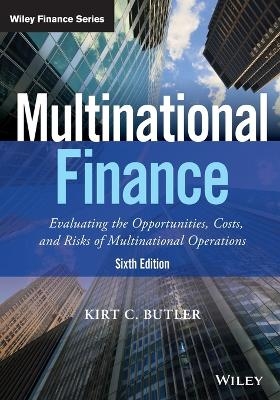
Multinational Finance
John Wiley & Sons Inc (Verlag)
978-1-119-21968-2 (ISBN)
Deep coverage and rigorous examination of international corporate finance Multinational Finance offers an advanced exploration of international corporate finance concepts and operations. Despite its status as one of the most rigorous texts on the topic, this book remains accessible and readable without sacrificing depth of coverage. Sidebars, key terms, essays, conceptual questions, and problems with solutions help aid in the learning process, while suggested readings and PowerPoint handouts reinforce the material and offer avenues for further exploration. This new sixth edition includes Excel templates that allow students to use real-world tools in a learning environment, and the modular structure facilitates course customization to individual objectives, interests, and preparatory level. The emphasis is on the basics of financial management, but coverage includes unique chapters on treasury management, asset pricing, hedging, options, and portfolio management in addition to traditional finance topics.
International finance is a diverse field with myriad specialties and a vast array of possible interests. This book allows students to view the field through the lens of a financial manager with investment or financial options in more than one country to give them a practical feel for real-world application.
Understand the nature and operations of international corporate finance
Evaluate opportunities, costs, and risks of multinational operations
See beyond the numbers and terminology to the general principles at work
Learn the markets, currencies, taxation, capital structure, governance, and more
Comprehensive, adaptable, and rigorously focused, this book gives students a solid foundation in international corporate finance, as well as a sound understanding of the tools and mechanics of the field. Designed for MBA and advanced undergraduate courses, Multinational Finance provides the deep coverage so essential to a solid education in finance.
KIRT C. BUTLER is an associate professor in the Department of Finance and Director of Study Abroad for the Eli Broad College of Business at Michigan State University, where he teaches multinational finance and global strategy.
Preface xi
Acknowledgments xv
About the Author xvii
Part One The International Financial Environment 1
Chapter 1 An Introduction to Multinational Finance 3
1.1 The Goals of the Multinational Corporation 3
1.2 The Challenges of Multinational Operations 5
1.3 The Opportunities of Multinational Operations 6
1.4 Financial Management of the Multinational Corporation 11
1.5 Summary 12
Chapter 2 World Trade and the International Monetary System 15
2.1 Integration of the World’s Markets 15
2.2 Balance-of-Payments Statistics 16
2.3 Exchange Rate Systems 18
2.4 A Brief History of the International Monetary System 22
2.5 Summary 31
Chapter 3 Foreign Exchange and Eurocurrency Markets 35
3.1 Characteristics of Financial Markets 35
3.2 The Eurocurrency Market 36
3.3 The Foreign Exchange Market 41
3.4 Foreign Exchange Rates and Quotations 44
3.5 Hedging with Currency Forwards 51
3.6 The Empirical Behavior of Exchange Rates 54
3.7 Summary 56
Chapter 4 The International Parity Conditions and Their Consequences 61
4.1 The Law of One Price 61
4.2 Exchange Rate Equilibrium 63
4.3 Covered Interest Arbitrage and Interest Rate Parity 66
4.4 Less Reliable International Parity Conditions 69
4.5 The Real Exchange Rate 74
4.6 Exchange Rate Forecasting 78
4.7 Summary 81
Appendix 4A: Continuous Compounding 88
Part Two Derivative Securities for Financial Risk Management 93
Chapter 5 Currency Futures and Futures Markets 95
5.1 The Evolution of Futures Markets 95
5.2 Futures Contracts 97
5.3 Forward versus Futures Market Hedges 100
5.4 Hedging with Currency Futures 104
5.5 Summary 113
Chapter 6 Currency Options and Options Markets 117
6.1 What Is an Option? 117
6.2 Option Payoff Profiles 119
6.3 Currency Option Values Prior to Expiration 126
6.4 Hedging with Currency Options 129
6.5 Exchange Rate Volatility Revisited 134
6.6 Summary 139
Appendix 6A: Currency Option Valuation 143
Chapter 7 Currency Swaps and Swaps Markets 149
7.1 The Growth of the Swaps Market 149
7.2 Swaps as Portfolios of Forward Contracts 151
7.3 Currency Swaps 153
7.4 Interest Rate Swaps 161
7.5 Other Types of Swaps 163
7.6 Hedging the Swap Bank’s Exposure to Financial Price Risk 165
7.7 Summary 166
Part Three Managing the Risks of Multinational Operations 171
Chapter 8 Multinational Treasury Management 173
8.1 Determining Financial Goals and Strategies 173
8.2 Managing International Trade 174
8.4 Managing Cash Flows 181
8.5 Managing Exposures to Currency Risk 183
8.6 Summary 190
Appendix 8A: The Rationale for Hedging Currency Risk 194
Chapter 9 Managing Transaction Exposure to Currency Risk 207
9.1 Transaction Exposure to Currency Risk 207
9.2 Managing Transaction Exposures Internally 208
9.3 Managing Transaction Exposures in the Financial Markets 214
9.4 Treasury Management in Practice 221
9.5 Summary 227
Chapter 10 Managing Operating Exposure to Currency Risk 231
10.1 Operating Exposures to Currency Risk 231
10.2 The Exposure of Shareholders’ Equity 234
10.3 Managing Operating Exposures in the Financial Markets 239
10.4 Managing Operating Exposures Through Operations 243
10.5 Pricing Strategy and the Competitive Environment 245
10.6 Summary 247
Chapter 11 Managing Translation Exposure and Accounting for Financial Transactions 253
11.1 Financial Accounting and Reporting Standards 253
11.2 The Current Rate Method of IAS 21 and ASC 830–30 255
11.3 Corporate Hedging of Translation Exposure 257
11.4 Accounting for Financial Market Instruments 260
11.5 Accounting, Disclosure, and Corporate Hedging Activities 265
11.6 Summary 266
Part Four Valuation and the Structure of Multinational Operations 273
Chapter 12 Foreign Market Entry and Country Risk Management 275
12.1 Strategic Entry into International Markets 276
12.2 Country Risk Assessment 281
12.3 Strategies for Managing Country Risk 287
12.4 Protecting the Multinational’s Competitive Advantages 293
12.5 Summary 296
Chapter 13 Multinational Capital Budgeting 299
13.1 The Algebra of Multinational Capital Budgeting 300
13.2 An Example: Wendy’s Restaurant in Neverland 303
13.3 International Parity Disequilibria 307
13.4 Special Circumstances in Cross-Border Investments 313
13.5 Summary 320
Chapter 14 Multinational Capital Structure and Cost of Capital 327
14.1 Capital Structure and the Cost of Capital 328
14.2 Valuation of a Foreign Project with the WACC 332
14.3 The Cost of Capital on Multinational Operations 337
14.4 Sources of Funds for Multinational Operations 341
14.5 The International Evidence of Capital Structure 346
14.6 Summary 348
Chapter 15 Taxes and Multinational Corporate Strategy 355
15.1 The Objectives of National Tax Policy 355
15.2 Types of Taxation 357
15.3 Taxes and Organization Form 360
15.4 U.S. Taxation of Foreign-Source Income 362
15.5 Transfer Pricing and Tax Planning 367
15.6 Taxes and the Location of Foreign Assets and Liabilities 370
15.7 Summary 374
Chapter 16 Real Options and Cross-Border Investment Strategy 379
16.1 Real Options and the Theory and Practice of Investment 379
16.2 Market Entry as a Simple Real Option 381
16.3 Uncertainty and the Value of the Option to Invest 389
16.4 Market Entry as a Compound Real Option 392
16.5 The Real Option Approach as Complement to NPV 395
16.6 Summary 398
Chapter 17 Corporate Governance and the International Market for Corporate Control 405
17.1 Corporate Governance 406
17.2 The International Market for Corporate Control 418
17.3 The International Evidence on Mergers and Acquisitions 424
17.4 Summary 428
Part Five International Portfolio Investment and Asset Pricing 433
Chapter 18 International Capital Markets 435
18.1 Domestic and International Capital Markets 435
18.2 International Investment Vehicles 444
18.3 Cross-Border Financial Statement Analysis 449
18.4 Summary 452
Chapter 19 International Portfolio Diversification 457
19.1 The Algebra of Portfolio Diversification 457
19.2 Returns on Foreign Investments 466
19.3 The Benefits of International Portfolio Diversification 473
19.4 Home Bias 475
19.5 Summary 480
Chapter 20 International Asset Pricing 485
20.1 The International Capital Asset Pricing Model (IAPM) 485
20.2 Factor Models of Expected and Required Return 490
20.3 Contemporary Asset Pricing Models 499
20.4 Summary 501
Appendix: Useful Rules and Formulas 509
Glossary 515
Index 533
| Erscheinungsdatum | 12.06.2016 |
|---|---|
| Reihe/Serie | Wiley Finance Editions |
| Verlagsort | New York |
| Sprache | englisch |
| Maße | 178 x 252 mm |
| Gewicht | 998 g |
| Themenwelt | Wirtschaft ► Betriebswirtschaft / Management ► Finanzierung |
| Wirtschaft ► Betriebswirtschaft / Management ► Rechnungswesen / Bilanzen | |
| Wirtschaft ► Betriebswirtschaft / Management ► Unternehmensführung / Management | |
| Wirtschaft ► Volkswirtschaftslehre ► Finanzwissenschaft | |
| Wirtschaft ► Volkswirtschaftslehre ► Makroökonomie | |
| ISBN-10 | 1-119-21968-X / 111921968X |
| ISBN-13 | 978-1-119-21968-2 / 9781119219682 |
| Zustand | Neuware |
| Informationen gemäß Produktsicherheitsverordnung (GPSR) | |
| Haben Sie eine Frage zum Produkt? |
aus dem Bereich


